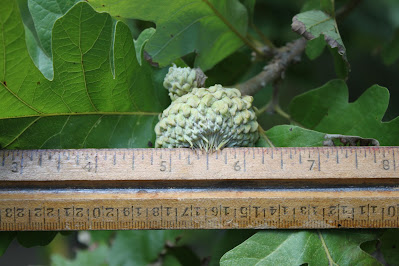 |
As part of our Acorn Watch 2022 series, we check in on the burr oak (Quercus macrocarpa). Exactly one year ago, we discussed this individual. You can read the post here. There is something about this tree that draws our attention each summer. It's the acorns! They are huge! Last year at this time, the burr oak was dropping immature acorns. Today, we have a different story.
|
 |
Imagine
what people are missing when they walk past this innocuous tree. All of
the lower limbs are removed, so you need to look up, to see the acorns.
|
 |
We have multiple photos of large, developing acorns still attached to the tree. These are only the acorns that we could reach. Looking up, large acorns could be seen going all the way up.
|
 |
These acorns appear to be developing very well.
|
 |
| The larger acorn is over an inch in diameter! |
 |
This tree is clearly doing well over an extended period to support multiple clusters of such large acorns.
|
 |
Last year, this burr oak was dropping immature acorns. As of today, the burr oak acorns are still attached, still maturing. So, what's the difference? At the begining of the summer, we were interested in the drought issue.
|
 |
Interestingly, last year, when the burr oak was dropping acorns, Louisiana had zero signs of drought.
|
 |
Right now, in August 2022, Louisiana is drier overall, and Caddo parish is particularly dry, as it is the only parish with an area of 'Extreme Drought'. However, our burr oak sits comfortably in the yellow zone, merely 'Abnormally Dry'. So, there isn't too much of a difference between this year and last year regarding drought conditions. Something else must be determining the fate of the acorns.
|
You can read our previous posts about the Burr oak
here,
here,
here, and
here.








